Abstract
The study of health effects induced by exposure to mixtures of pollutants is a complex task. The purpose of this paper is to identify areas of research in which the conduct of human controlled exposure (clinical) studies may contribute to better understanding health effects of exposure to indoor air and other mixtures. The strengths and weaknesses of clinical studies in general are reviewed, as well as examples from the literature of approaches that have been used. Human chamber studies play an important role alongside epidemiologic and animal toxicologic studies in such research. Human chamber studies are limited with regard to assessing chronic effects, rare effects, or effects from long-duration exposures but are powerful in assessing acute, reversible effects from short-duration exposures in humans. The areas in which human chamber studies are most likely to contribute include identification of effects or markers of effects for exposure to a given pollutant or mix of pollutants; direct dose-response assessment of effects for individual compounds and mixtures of set composition; identification of individual compounds responsible for the effects of a mixture; study of the joint effects of a binary mixture; development of markers of acute exposure for particular compounds; development of outcome measurements to be used in the field; and identification, characterization, and testing of sensitive subpopulations.
Full text
PDF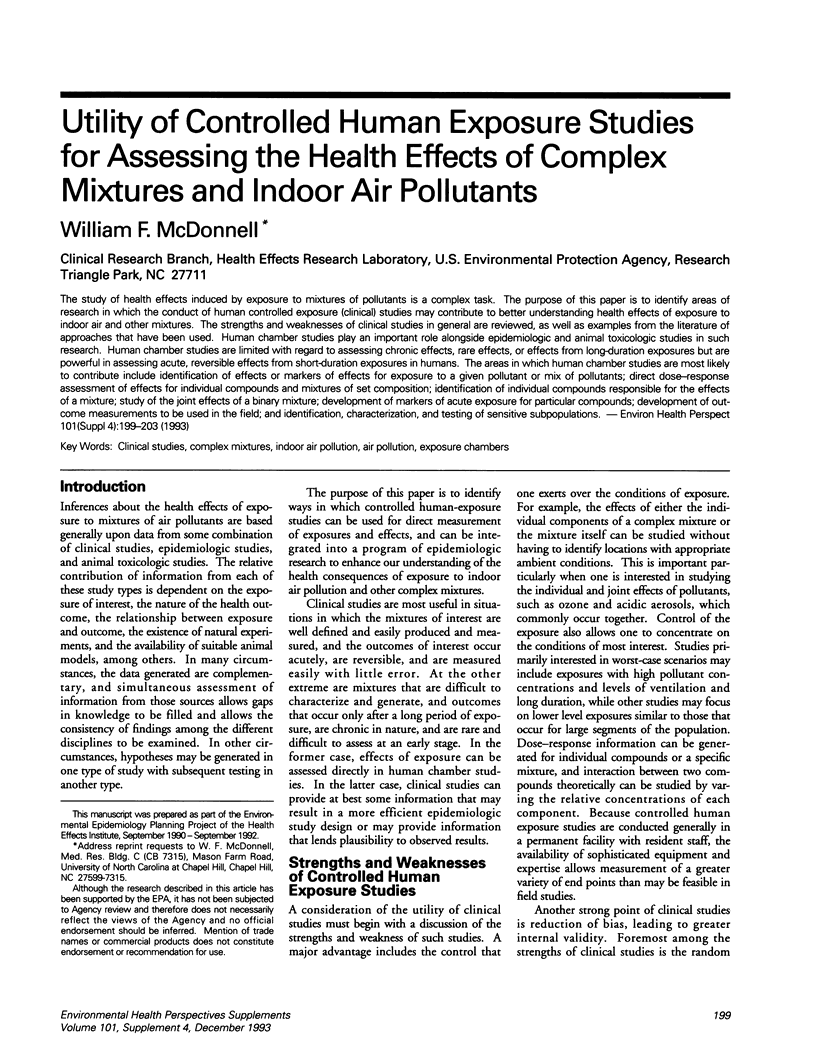
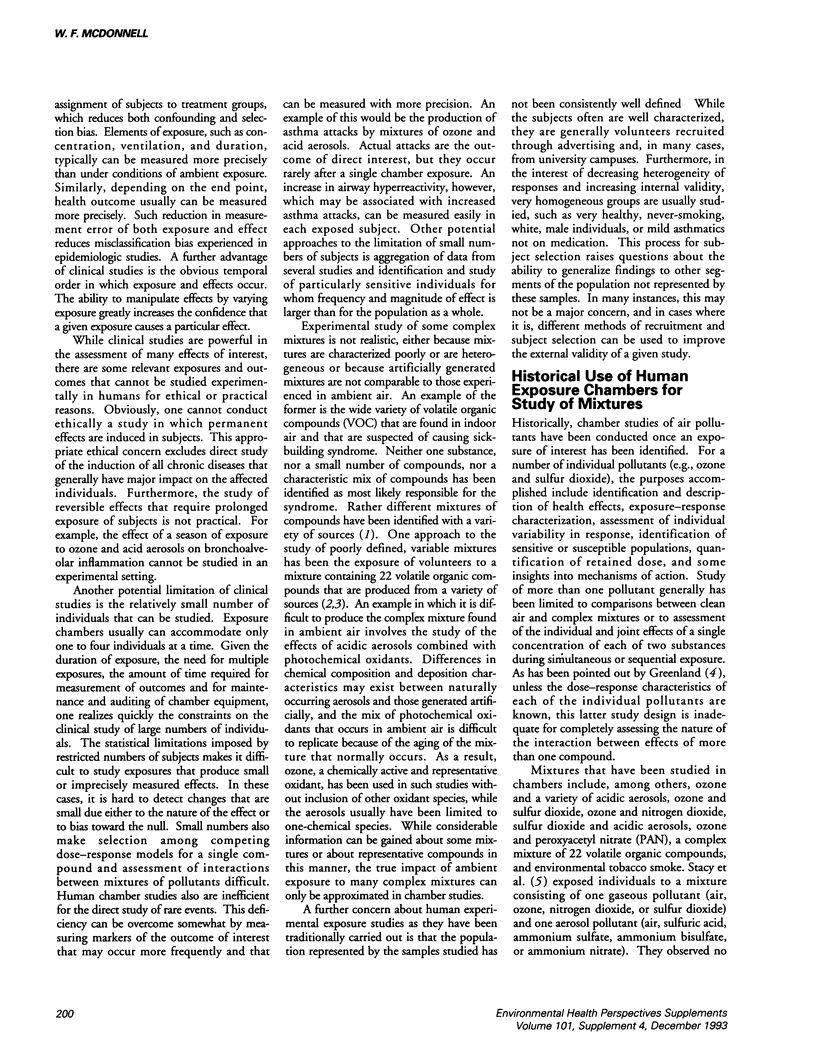
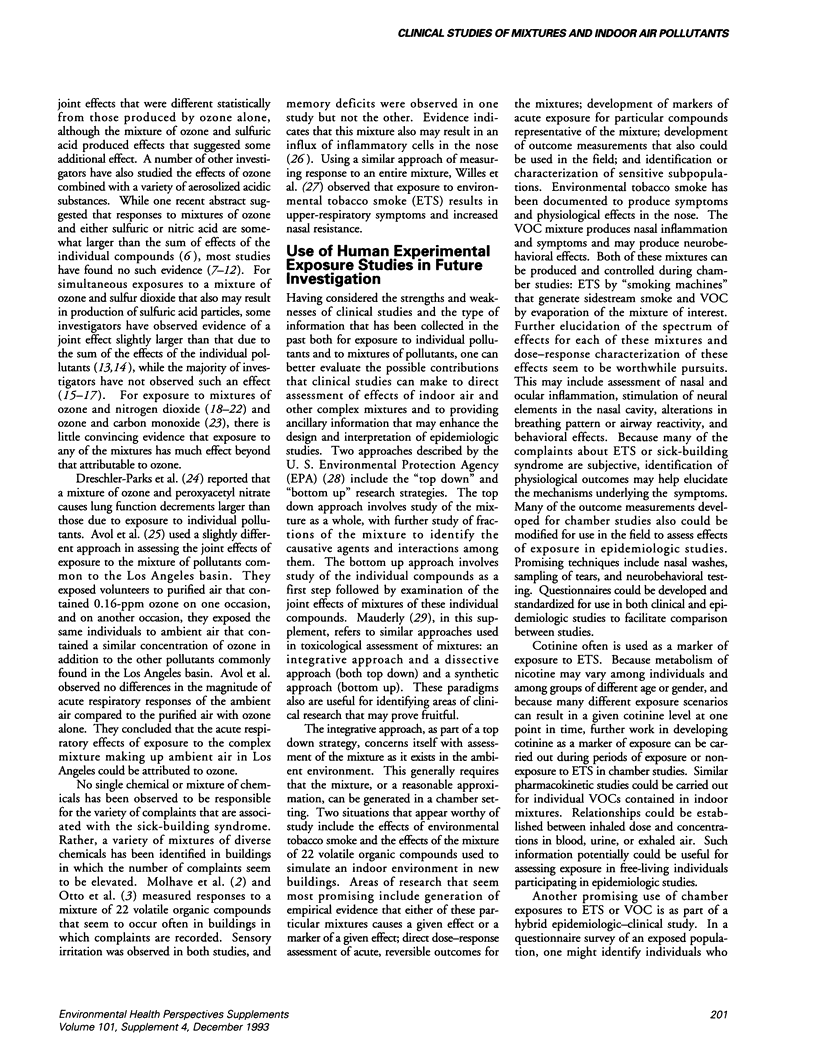
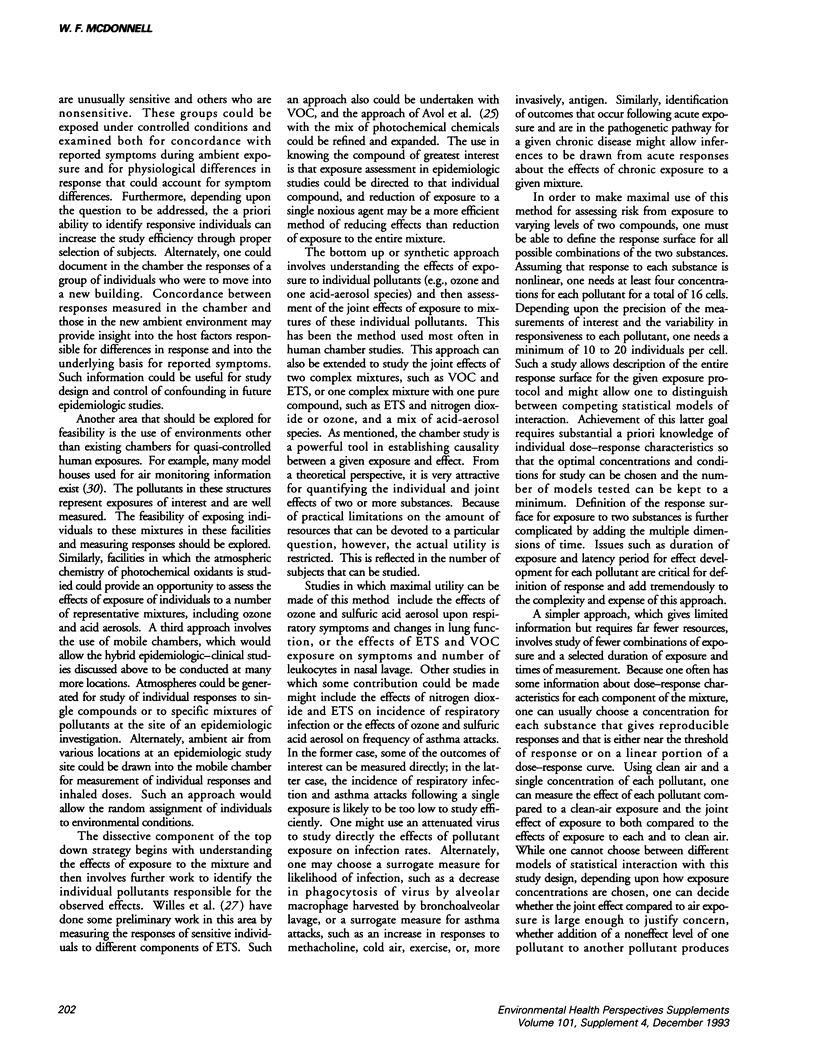
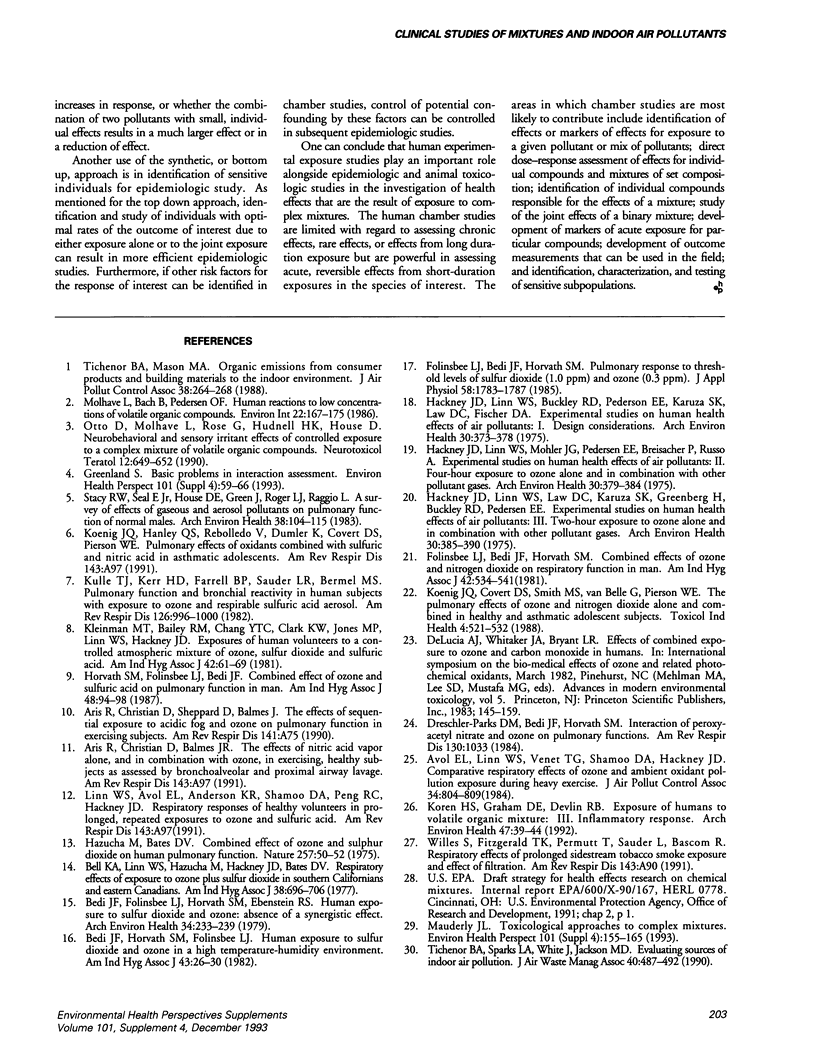
Selected References
These references are in PubMed. This may not be the complete list of references from this article.
- Avol E. L., Linn W. S., Venet T. G., Shamoo D. A., Hackney J. D. Comparative respiratory effects of ozone and ambient oxidant pollution exposure during heavy exercise. J Air Pollut Control Assoc. 1984 Aug;34(8):804–809. doi: 10.1080/00022470.1984.10465814. [DOI] [PubMed] [Google Scholar]
- Bedi J. F., Folinsbee L. J., Horvath S. M., Ebenstein R. S. Human exposure to sulfur dioxide and ozone: absence of a synergistic effect. Arch Environ Health. 1979 Jul-Aug;34(4):233–239. doi: 10.1080/00039896.1979.10667405. [DOI] [PubMed] [Google Scholar]
- Bedi J. F., Horvath S. M., Folinsbee L. J. Human exposure to sulfur dioxide and ozone in a high temperature-humidity environment. Am Ind Hyg Assoc J. 1982 Jan;43(1):26–30. doi: 10.1080/15298668291409316. [DOI] [PubMed] [Google Scholar]
- Bell K. A., Linn W. S., Hazucha M., Hackney J. D., Bates D. V. Respiratory effects of exposure to ozone plus sulfur dioxide in Southern Californians and Eastern Canadians. Am Ind Hyg Assoc J. 1977 Dec;38(12):696–706. doi: 10.1080/0002889778507681. [DOI] [PubMed] [Google Scholar]
- Drechsler-Parks D. M., Bedi J. F., Horvath S. M. Interaction of peroxyacetyl nitrate and ozone on pulmonary functions. Am Rev Respir Dis. 1984 Dec;130(6):1033–1037. doi: 10.1164/arrd.1984.130.6.1033. [DOI] [PubMed] [Google Scholar]
- Folinsbee L. J., Bedi J. F., Horvath S. M. Combined effects of ozone and nitrogen dioxide on respiratory function in man. Am Ind Hyg Assoc J. 1981 Jul;42(7):534–541. doi: 10.1080/15298668191420206. [DOI] [PubMed] [Google Scholar]
- Folinsbee L. J., Bedi J. F., Horvath S. M. Pulmonary response to threshold levels of sulfur dioxide (1.0 ppm) and ozone (0.3 ppm). J Appl Physiol (1985) 1985 Jun;58(6):1783–1787. doi: 10.1152/jappl.1985.58.6.1783. [DOI] [PubMed] [Google Scholar]
- Greenland S. Basic problems in interaction assessment. Environ Health Perspect. 1993 Dec;101 (Suppl 4):59–66. doi: 10.1289/ehp.93101s459. [DOI] [PMC free article] [PubMed] [Google Scholar]
- Hackney J. D., Linn W. S., Buckley R. D., Pedersen E. E., Karuza S. K., Law D. C., Fischer A. Experimental studies on human health effects of air pollutants: I. Design considerations. Arch Environ Health. 1975 Aug;30(8):373–378. doi: 10.1080/00039896.1975.10666728. [DOI] [PubMed] [Google Scholar]
- Hackney J. D., Linn W. S., Law D. C., Karuza S. K., Greenberg H., Buckley R. D., Pedersen E. E. Experimental studies on human health effects of air pollutants. III. Two-hour exposure to ozone alone and in combination with other pollutant gases. Arch Environ Health. 1975 Aug;30(8):385–390. doi: 10.1080/00039896.1975.10666730. [DOI] [PubMed] [Google Scholar]
- Hackney J. D., Linn W. S., Mohler J. G., Pedersen E. E., Breisacher P., Russo A. Experimental studies on human health effects of air pollutants. II. Four-hour exposure to ozone alone and in combination with other pollutant gases. Arch Environ Health. 1975 Aug;30(8):379–384. doi: 10.1080/00039896.1975.10666729. [DOI] [PubMed] [Google Scholar]
- Hazucha M., Bates D. V. Combined effect of ozone and sulphur dioxide on human pulmonary function. Nature. 1975 Sep 4;257(5521):50–51. doi: 10.1038/257050a0. [DOI] [PubMed] [Google Scholar]
- Horvath S. M., Folinsbee L. J., Bedi J. F. Combined effect of ozone and sulfuric acid on pulmonary function in man. Am Ind Hyg Assoc J. 1987 Feb;48(2):94–98. doi: 10.1080/15298668791384454. [DOI] [PubMed] [Google Scholar]
- Kleinman M. T., Bailey R. M., Chang Y. T., Clark K. W., Jones M. P., Linn W. S., Hackney J. D. Exposures of human volunteers to a controlled atmospheric mixture of ozone, sulfur dioxide and sulfuric acid. Am Ind Hyg Assoc J. 1981 Jan;42(1):61–69. doi: 10.1080/15298668191419361. [DOI] [PubMed] [Google Scholar]
- Koenig J. Q., Covert D. S., Smith M. S., van Belle G., Pierson W. E. The pulmonary effects of ozone and nitrogen dioxide alone and combined in healthy and asthmatic adolescent subjects. Toxicol Ind Health. 1988 Dec;4(4):521–532. doi: 10.1177/074823378800400410. [DOI] [PubMed] [Google Scholar]
- Koren H. S., Graham D. E., Devlin R. B. Exposure of humans to a volatile organic mixture. III. Inflammatory response. Arch Environ Health. 1992 Jan-Feb;47(1):39–44. doi: 10.1080/00039896.1992.9935942. [DOI] [PubMed] [Google Scholar]
- Kulle T. J., Kerr H. D., Farrell B. P., Sauder L. R., Bermel M. S. Pulmonary function and bronchial reactivity in human subjects with exposure to ozone and respirable sulfuric acid aerosol. Am Rev Respir Dis. 1982 Dec;126(6):996–1000. doi: 10.1164/arrd.1982.126.6.996. [DOI] [PubMed] [Google Scholar]
- Mauderly J. L. Toxicological approaches to complex mixtures. Environ Health Perspect. 1993 Dec;101 (Suppl 4):155–165. doi: 10.1289/ehp.93101s4155. [DOI] [PMC free article] [PubMed] [Google Scholar]
- Otto D., Molhave L., Rose G., Hudnell H. K., House D. Neurobehavioral and sensory irritant effects of controlled exposure to a complex mixture of volatile organic compounds. Neurotoxicol Teratol. 1990 Nov-Dec;12(6):649–652. doi: 10.1016/0892-0362(90)90079-r. [DOI] [PubMed] [Google Scholar]
- Stacy R. W., Seal E., Jr, House D. E., Green J., Roger L. J., Raggio L. A survey of effects of gaseous and aerosol pollutants on pulmonary function of normal males. Arch Environ Health. 1983 Mar-Apr;38(2):104–115. doi: 10.1080/00039896.1983.10543989. [DOI] [PubMed] [Google Scholar]
- Tichenor B. A., Mason M. A. Organic emissions from consumer products and building materials to the indoor environment. JAPCA. 1988 Mar;38(3):264–268. doi: 10.1080/08940630.1988.10466376. [DOI] [PubMed] [Google Scholar]
- Tichenor B. A., Sparks L. A., White J. B., Jackson M. D. Evaluating sources of indoor air pollution. J Air Waste Manage Assoc. 1990 Apr;40(4):487–492. doi: 10.1080/10473289.1990.10466703. [DOI] [PubMed] [Google Scholar]


